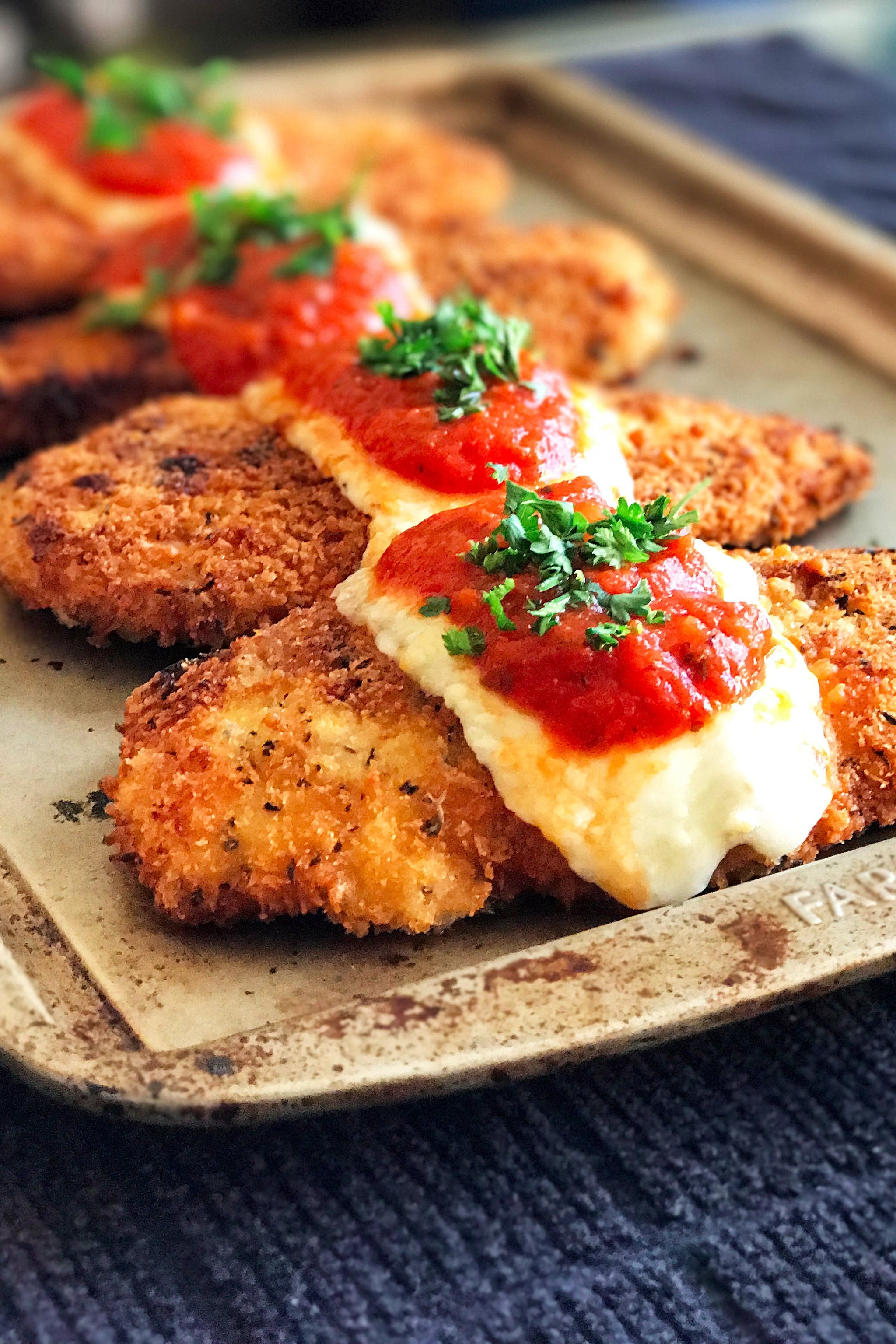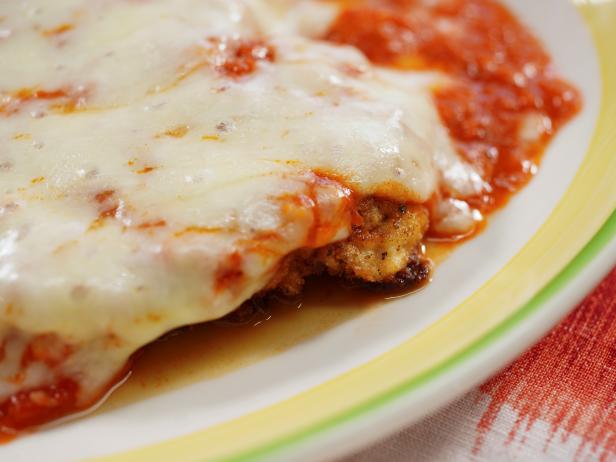Video tentang Chicken Parmesan: A Deep Dive into the Crispy, Cheesy Classic
Chicken Parmesan: A Deep Dive into the Crispy, Cheesy Classic

Chicken Parmesan. The name itself conjures images of golden-brown, crispy-crusted chicken breasts, smothered in a rich, tangy tomato sauce, and generously layered with melted mozzarella cheese. It’s a dish that transcends simple comfort food; it’s a culinary experience, a symphony of textures and flavors that has captivated palates for generations. But the seemingly straightforward dish holds a surprising depth, a story woven into its crispy crust and bubbling cheese. This article will explore the history, variations, techniques, and cultural significance of Chicken Parmesan, revealing why it remains a beloved classic.
A History Steeped in Tradition (and a Little Debate):
Pinpointing the precise origin of Chicken Parmesan is a surprisingly challenging task. While many believe it to be a purely American invention, its roots are likely intertwined with the Italian-American culinary tradition. The dish’s components – breaded cutlets, tomato sauce, and cheese – all have long and distinct histories within Italian cuisine. The Milanese-style cotoletta alla Milanese, a breaded veal cutlet, serves as a strong ancestor, its crispy breading providing a foundation for the Chicken Parmesan technique.
The evolution likely involved a substitution of the more expensive veal with readily available chicken, a practical adjustment reflecting the realities of immigrant life in America. The addition of tomato sauce and cheese, staples of Italian cooking, further solidified the dish’s identity, transforming a simple breaded cutlet into the cheesy, saucy delight we know and love. While a definitive "inventor" remains elusive, the dish’s emergence likely occurred in the mid-20th century, gaining popularity in Italian-American restaurants and homes across the country. Its rise to prominence coincided with the growing accessibility of ingredients and the increasing popularity of Italian-American cuisine.
The Anatomy of a Perfect Chicken Parmesan:
The seemingly simple dish relies on a delicate balance of several key components, each contributing to the overall harmony of flavors and textures.
-
The Chicken: The choice of chicken is crucial. While boneless, skinless chicken breasts are the most common choice, for a richer flavor and juicier result, consider using boneless, skin-on breasts. The skin adds a layer of crispiness and prevents the chicken from drying out during cooking. The chicken should be pounded to an even thickness, ensuring even cooking and a tender final product.
-
The Breading: The breading is the cornerstone of the Chicken Parmesan experience. A classic breading typically involves dredging the chicken in flour, then dipping it in beaten eggs, and finally coating it thoroughly in breadcrumbs. Many variations exist, with some recipes incorporating Parmesan cheese into the breadcrumbs for an extra layer of flavor and richness. Panko breadcrumbs are a popular choice for their extra-crispy texture.
-
The Frying: The frying process is critical for achieving that signature golden-brown, crispy crust. Using a sufficient amount of oil (vegetable, canola, or even a blend) at the correct temperature is essential. Overcrowding the pan will lower the oil temperature, resulting in soggy chicken. Frying in batches ensures even browning and crispiness.

-
The Sauce: The tomato sauce is the heart of the dish, providing a tangy, savory counterpoint to the richness of the cheese and chicken. A simple marinara sauce works perfectly, but many variations exist, incorporating herbs, spices, and even a touch of sweetness. Homemade sauces offer superior flavor and depth, but high-quality store-bought options can also deliver excellent results.

The Cheese: Mozzarella cheese is the traditional choice, its melting properties creating a gooey, stretchy layer of cheesy goodness. Fresh mozzarella, with its delicate texture and milky flavor, is ideal, but shredded mozzarella is a convenient alternative. Some recipes incorporate other cheeses, such as provolone or Parmesan, for added complexity.
-
The Baking (or Broiling): After frying, the breaded chicken is typically baked or broiled with the sauce and cheese, allowing the cheese to melt and bubble, creating a beautifully browned and bubbly top. Baking provides a more even cooking process, while broiling delivers a crispier cheese topping.

Variations on a Theme:
The beauty of Chicken Parmesan lies in its adaptability. Countless variations exist, each reflecting regional preferences and personal tastes.
-
Veal Parmesan: A return to the dish’s roots, veal Parmesan utilizes veal cutlets instead of chicken, offering a richer, more delicate flavor.
-
Eggplant Parmesan: A vegetarian alternative, eggplant Parmesan replaces the chicken with slices of eggplant, providing a similar textural experience with a slightly earthier flavor.
-
Spicy Chicken Parmesan: Adding red pepper flakes or a touch of hot sauce to the tomato sauce introduces a welcome kick of heat.
-
Gourmet Chicken Parmesan: Elevating the dish with higher-quality ingredients, such as artisan bread crumbs, fresh herbs, and imported cheeses, creates a truly luxurious experience.
-
Chicken Parmesan Sandwiches: A more casual approach, the Chicken Parmesan sandwich utilizes the classic components within a bread roll or sub, creating a satisfying and portable meal.
Beyond the Plate: Cultural Significance and Modern Interpretations:
Chicken Parmesan’s popularity extends far beyond its culinary appeal. It represents a significant aspect of Italian-American culture, reflecting the adaptation and evolution of traditional Italian dishes within a new context. It’s a dish that evokes feelings of nostalgia, family gatherings, and comfort.
In recent years, Chicken Parmesan has also seen a resurgence in popularity, with chefs and restaurants experimenting with new and innovative interpretations. From gourmet versions featuring artisanal ingredients to fusion dishes incorporating international flavors, the dish continues to adapt and evolve, while retaining its core identity.
Mastering the Technique: Tips and Tricks for Success:
Creating the perfect Chicken Parmesan requires attention to detail and a few key techniques:
-
Don’t overcrowd the pan: Frying in batches ensures even browning and prevents the oil temperature from dropping.
-
Use a thermometer: Monitoring the oil temperature is crucial for achieving a crispy crust without burning the chicken.
-
Pound the chicken evenly: This ensures even cooking and prevents some parts from becoming overcooked while others remain undercooked.
-
Let the chicken rest: Allowing the fried chicken to rest for a few minutes before adding the sauce and cheese helps prevent the breading from becoming soggy.
-
Don’t overbake: Overbaking can dry out the chicken and burn the cheese.
Conclusion:
Chicken Parmesan is more than just a dish; it’s a culinary journey, a testament to the adaptability and enduring appeal of classic Italian-American cuisine. Its simple yet satisfying nature, combined with its endless variations, ensures its continued popularity for generations to come. Whether enjoyed as a family meal, a casual weeknight dinner, or a gourmet restaurant experience, Chicken Parmesan remains a timeless classic, a dish that consistently delivers a comforting and delicious experience. So, gather your ingredients, embrace the technique, and embark on your own Chicken Parmesan adventure. The crispy crust, the bubbling cheese, and the rich tomato sauce await.

Penutup
Therefore, we hope this article has provided valuable insights on Chicken Parmesan: A Deep Dive into the Crispy, Cheesy Classic. We thank you for the time you spent reading this article . See you in our next article!

